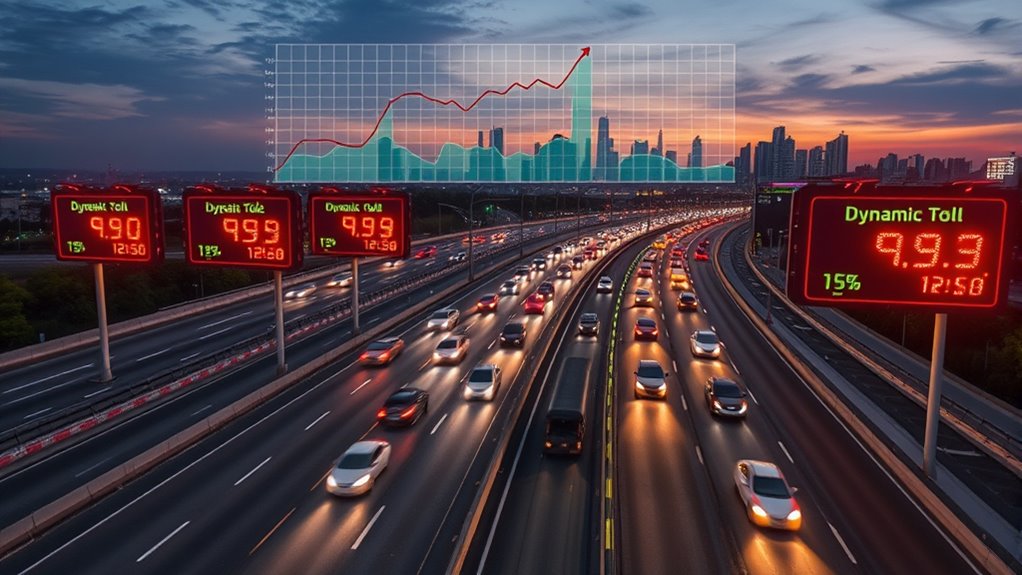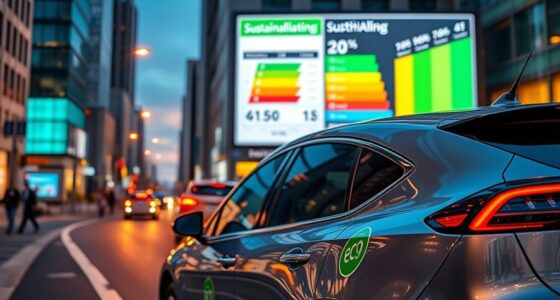Dynamic road pricing adjusts tolls in real time based on traffic flow to reduce vehicle emissions. By encouraging you to travel during off-peak hours or take alternative routes, it helps cut congestion and pollution. Technologies like GPS, sensors, and connected vehicles support these systems for precise adjustments. Successful examples from cities worldwide show how smart pricing can promote eco-friendly driving habits. Keep exploring to discover how these strategies can make transportation cleaner and more efficient.
Key Takeaways
- Dynamic road pricing incentivizes off-peak travel, reducing congestion and vehicle emissions during peak hours.
- Real-time toll adjustments encourage route and travel time shifts, lowering overall emission levels.
- Revenue from congestion charges funds public transit and infrastructure, promoting cleaner transportation alternatives.
- Incentivizing eco-friendly vehicles during high-cost periods supports the adoption of low-emission technologies.
- Data-driven pricing algorithms optimize traffic flow, minimizing idling and stop-and-go driving that increase emissions.
Understanding the Concept of Dynamic Road Pricing

Have you ever wondered how cities manage traffic congestion and reduce travel times? Dynamic road pricing is a smart approach that adjusts tolls based on real-time traffic flow. It aims to ease urban congestion by encouraging drivers to shift their travel times or routes. Unlike flat tolls, dynamic pricing promotes toll fairness by charging higher rates during peak hours and lower rates when traffic is lighter. This system helps distribute traffic more evenly across the day, preventing bottlenecks and reducing overall congestion. By implementing variable tolls, cities can better manage road usage, make transportation more efficient, and improve air quality. Additionally, integrating high refresh rates into traffic monitoring systems can provide more accurate real-time data for optimal pricing adjustments. Essentially, dynamic road pricing aligns incentives for drivers to travel smarter, easing urban congestion while ensuring toll fairness.
How Dynamic Pricing Influences Vehicle Emissions

When dynamic pricing adjusts in real time, you’re encouraged to change your driving habits to save money and avoid congestion. These behavioral shifts can lead to fewer vehicles on the road and lower emissions overall. As a result, cities can see meaningful reductions in air pollution and carbon footprint.
Real-time Price Adjustments
Real-time price adjustments directly influence vehicle emissions by encouraging drivers to modify their travel behaviors in response to changing costs. When prices fluctuate throughout the day, you’re motivated to avoid peak hours, reducing urban congestion. Less congestion means vehicles idle less and travel more smoothly, lowering emissions. These dynamic prices also push you to consider alternative fuels, especially when costs for traditional gasoline or diesel rise. As prices increase during busy periods, you might opt for electric, hybrid, or biofuel-powered vehicles, which emit fewer pollutants. This responsive pricing system creates immediate incentives to shift travel patterns, helping you make conscious choices that decrease overall emissions. Additionally, understanding risk assessment in merchant services highlights the importance of secure and reliable payment systems to support such innovative transportation initiatives. Over time, these adjustments contribute notably to cleaner air and more sustainable urban environments.
Behavioral Driving Changes
Dynamic pricing prompts drivers to change their travel behaviors, resulting in reduced vehicle emissions. When prices fluctuate based on congestion, you’re encouraged to adjust your travel times or routes, driven by behavioral incentives. These incentives motivate you to avoid peak hours or crowded roads, helping to spread traffic more evenly. As a result, driver compliance with these pricing signals increases, leading to less idling and smoother traffic flow. You might choose to carpool, use alternative routes, or plan trips during cheaper off-peak periods. These behavioral changes directly contribute to lowering emissions, as fewer cars sit idle or accelerate unnecessarily. Incorporating driver behavior modification strategies enhances the effectiveness of dynamic pricing in reducing traffic-related pollution. Overall, dynamic pricing effectively influences your driving habits, fostering more environmentally friendly travel patterns without requiring strict mandates.
Emission Reduction Outcomes
How does dynamic road pricing directly impact vehicle emissions? By reducing urban congestion, it encourages you and other commuters to change your behavior, such as traveling during off-peak hours or choosing alternative routes. Less congestion means vehicles spend less time idling and stop-and-go driving, leading to lower emissions. As traffic flow improves, emissions of pollutants like carbon dioxide and nitrogen oxides decrease. Additionally, using low heat settings on devices like curling irons when styling wigs can prevent damage and extend their lifespan, promoting sustainability. The pricing signals create an incentive for you to adapt your travel patterns, which collectively results in cleaner air and a healthier environment. Over time, these shifts in commuter behavior, driven by dynamic pricing, produce significant emission reduction outcomes, making urban areas more sustainable and less polluted.
Technologies and Systems Supporting Real-Time Toll Adjustments

You rely on traffic data collection systems to monitor road conditions in real time. These systems feed information into dynamic pricing algorithms that determine ideal toll rates instantly. Communication networks then deliver these updates directly to drivers, ensuring smooth and responsive toll adjustments. Incorporating real-time data collection enhances the accuracy and efficiency of the pricing system.
Traffic Data Collection
Effective traffic data collection relies on a suite of advanced technologies and systems that capture real-time information about vehicle flow and congestion. You use sensors, cameras, GPS data, and connected vehicle systems to monitor traffic conditions continuously. This data supports dynamic toll adjustments, helping reduce emissions and optimize traffic flow. Accurate data also influences parking fees and insurance premiums, encouraging eco-friendly driving. To illustrate, consider this table:
| Technology | Function | Benefit |
|---|---|---|
| Inductive loops | Detect vehicle presence and speed | Precise traffic flow data |
| CCTV cameras | Visual monitoring of congestion | Accurate real-time info |
| GPS tracking | Vehicle location and movement analysis | Dynamic pricing support |
These systems enable responsive tolls, promoting cleaner transportation and smarter urban mobility. Advancements in automation and sensor technology further enhance the accuracy and responsiveness of traffic management systems, contributing to more sustainable urban environments.
Dynamic Pricing Algorithms
Dynamic pricing algorithms are at the core of real-time toll adjustments, leveraging sophisticated technologies to analyze traffic data and optimize road usage. These algorithms respond quickly to urban congestion by adjusting toll rates, encouraging drivers to shift travel times or routes. They aim to balance traffic flow, reducing delays and emissions. They consider factors like current congestion levels and historical patterns, which helps maintain effective space management, preventing disproportionate charges on certain drivers or routes. You benefit from more predictable travel times and fair pricing, while urban congestion decreases due to smarter demand management. Effective algorithms create a dynamic pricing environment that adapts seamlessly, promoting efficient road use and supporting emission reduction goals without overburdening any particular group of drivers.
Real-Time Communication Systems
Real-time communication systems are essential for implementing dynamic toll adjustments, as they enable instant data exchange between traffic management centers, vehicles, and roadside infrastructure. These systems support timely updates to vehicle incentives and parking fees, encouraging efficient traffic flow. To optimize their effectiveness, you should consider:
- Leveraging Vehicle-to-Infrastructure (V2I) technology to relay current toll rates and parking fee changes instantly.
- Using wireless communication protocols, like DSRC or 5G, for low-latency data transfer that ensures real-time responses.
- Integrating vehicle data with traffic sensors to adjust pricing dynamically based on congestion levels and emission reduction goals.
- Incorporating tuning principles to enhance system responsiveness and reliability, ensuring smoother communication and better traffic management.
Case Studies: Successful Implementations Worldwide

Across the globe, cities have successfully implemented dynamic road pricing to manage congestion and reduce pollution. These programs often gained strong public acceptance by demonstrating clear benefits, like shorter travel times and cleaner air. For example, London’s congestion charge reduced traffic and improved air quality, while Stockholm’s congestion tax saw high compliance due to transparent communication. The economic impact has generally been positive, generating revenue that funds public transportation and infrastructure improvements. These cities also showed that involving local communities and stakeholders early on fosters support and trust. By addressing concerns about fairness and ensuring affordable alternatives, they set a precedent for successful adoption. Additionally, integrating sustainable transportation initiatives with pricing strategies can amplify environmental benefits. These case studies prove that with proper planning, dynamic pricing can deliver environmental benefits without significant economic drawbacks.
Challenges and Considerations in Deploying Dynamic Pricing

Implementing dynamic road pricing presents several challenges that must be carefully managed to guarantee success. First, addressing equity concerns is vital, as higher prices may disproportionately impact low-income drivers, raising questions of fairness. Second, designing pricing fairness involves setting rates that reflect congestion and pollution levels without penalizing users unfairly. Third, public acceptance can be difficult; drivers may resist changes if they feel the system is unjust or opaque. To overcome these challenges, you need transparent communication, inclusive policy design, and equitable revenue use. Balancing environmental goals with social fairness requires careful planning and stakeholder engagement. Additionally, considering vape juice shelf life and proper storage practices can serve as an analogy for maintaining system integrity and longevity. Without attention to equity concerns and pricing fairness, even well-intentioned dynamic pricing schemes risk public opposition and ineffective emissions reduction.
Future Perspectives and Policy Recommendations

Looking ahead, effective policies and strategic planning are essential to maximize the benefits of dynamic road pricing while addressing its challenges. You should focus on integrating urban planning that promotes sustainable transportation and reduces congestion. Policymakers need to foster robust public engagement to build trust and ensure community needs are considered. Transparent communication about pricing mechanisms and environmental benefits encourages public acceptance. Emphasizing equitable access prevents disproportionate impacts on vulnerable populations. Future policies should also leverage technological innovations to improve system efficiency. Collaboration between government, industry, and citizens will be crucial to shaping adaptable frameworks. By aligning urban planning, public engagement, and innovative solutions, you can develop dynamic road pricing strategies that effectively reduce emissions and support sustainable urban growth.
Frequently Asked Questions
How Does Dynamic Pricing Impact Public Transportation Usage?
You might notice that when road prices change dynamically, public transit becomes more attractive because driving costs increase during peak times. This encourages a modal shift, where more people opt for public transit instead of personal vehicles. As a result, public transit usage rises, helping reduce congestion and emissions. Dynamic pricing effectively influences travel choices, making public transit a more convenient and economical option during high-cost periods.
What Are the Privacy Concerns Related to Real-Time Vehicle Data Collection?
You might worry about privacy when real-time vehicle data is collected, especially with vehicle tracking systems. Your location and travel habits could be monitored, raising concerns about data security. If this information falls into the wrong hands, it could lead to misuse or breaches. It’s essential for agencies to implement strict data security measures to protect your privacy and guarantee your vehicle data isn’t exploited or shared without your consent.
How Do Drivers Perceive and Respond to Fluctuating Toll Prices?
You likely notice that fluctuating toll prices influence your driving behavior, as you respond to real-time cost changes. Your behavioral response depends on your pricing perception—whether you see the tolls as fair or excessive. When prices rise unexpectedly, you might seek alternative routes or delay trips. Conversely, lower tolls can encourage you to use certain roads more often. Overall, your reactions shape traffic flow and your overall experience.
What Are the Long-Term Economic Effects of Dynamic Road Pricing?
You might wonder about the long-term economic effects of dynamic road pricing. It can promote economic sustainability by reducing congestion and pollution, leading to healthier communities. Additionally, it encourages market competitiveness by incentivizing transportation efficiency and innovation. Over time, you could see more balanced infrastructure investments and better resource allocation, which benefits the economy overall. This approach helps create a resilient transportation system that supports both growth and environmental goals.
How Can Equity Be Ensured in Dynamic Pricing Schemes?
Did you know that nearly 60% of commuters worry about fairness in pricing schemes? To guarantee equity considerations, you should implement fairness strategies like tiered pricing or discounts for low-income households. By actively addressing these concerns, you make sure that everyone benefits fairly from the system. This approach helps prevent disproportionate burdens and promotes social justice, ensuring that dynamic pricing schemes are inclusive and equitable for all users.
Conclusion
As you explore dynamic road pricing, remember it gently guides us toward cleaner roads and a healthier environment. While it may seem like a subtle nudge, it encourages mindful driving choices and smarter infrastructure use. Embracing this approach means trusting in a future where progress and sustainability walk hand in hand. Ultimately, it’s about creating a balanced journey—where innovation quietly whispers the promise of a greener, more harmonious world for everyone.










